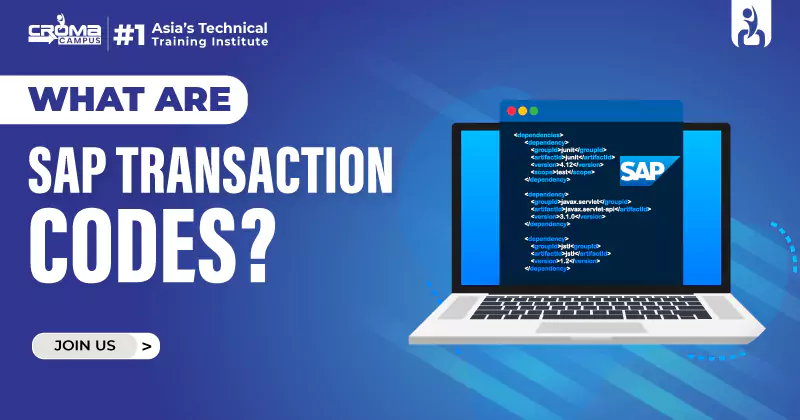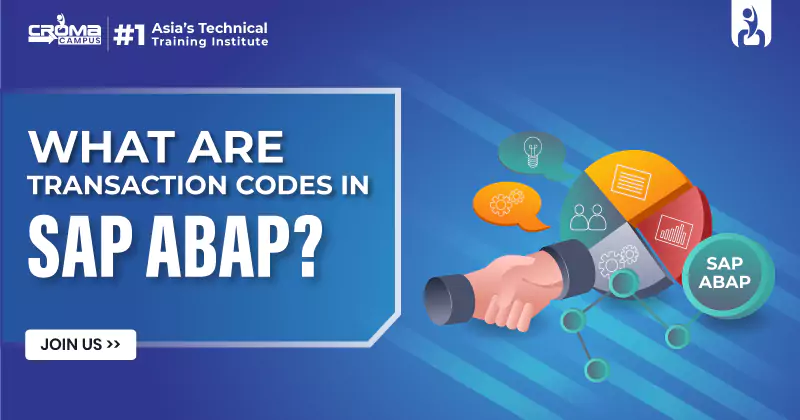What Are SAP Transactions Codes?
4.9 out of 5 based on 9874 votesLast updated on 25th Oct 2024 19.7K Views
- Bookmark

T-Codes in SAP are shortcut codes used to access specific tasks or transactions, simplifying navigation and boosting efficiency in workflows.

Introduction
SAP Transaction Codes (T-Codes) are essential shortcuts within the SAP system, enabling users to quickly access specific transactions or tasks without navigating through complex menus. These alphanumeric codes are linked to various functions across SAP modules like Materials Management (MM), Financial Accounting (FICO), and Sales and Distribution (SD). By entering a T-Code into the command field, users can directly initiate processes such as creating purchase orders or posting financial documents. T-Codes streamline workflows, improve efficiency, and allow for customization, making them a critical tool for SAP users to execute business operations effectively and with speed. Consider joining SAP Training and Placement for the best guidance.
All About SAP
SAP (Systems, Applications, and Products in Data Processing) is a leading enterprise resource planning (ERP) software developed by SAP SE. It integrates core business functions like finance, sales, logistics, and human resources into a single system, providing companies with centralized data management.
SAP's modular design allows businesses to pick specific modules based on their needs. Commonly used modules include:
- SAP FICO (Financial Accounting and Controlling): Handles financial operations and reporting.
- SAP MM (Materials Management): Manages procurement and inventory processes.
- SAP SD (Sales and Distribution): Manages sales processes and customer relationships.
- SAP HR (Human Resources): Streamlines employee management and payroll.
One of SAP's biggest advantages is real-time data processing, allowing for timely and accurate business decisions. SAP systems can be deployed on-premises, in the cloud, or as a hybrid solution, giving companies flexibility in implementation. Moreover, many SAP Shortcut Keys help make working with SAP easier.
The latest version, SAP S4 HANA, leverages in-memory computing technology for faster analytics and transactions, offering a more intuitive user experience.
SAP is used by companies of all sizes worldwide to optimize processes, reduce costs, and improve productivity. As businesses continue to embrace digital transformation, SAP remains crucial for enterprises aiming for operational efficiency and competitive advantage.
SAP professionals can pursue various certifications and roles like SAP consultants, developers, and analysts, making it a valuable skill set in the IT industry.
What Are SAP Transactions Codes?
SAP Transaction Codes (T-Codes) are unique alphanumeric codes used to execute specific tasks within the SAP system. These codes act as shortcuts, allowing users to access particular applications, reports, or functions without navigating through multiple menu layers. Moreover, all SAP tcodes are essential parts of SAP's interface, streamlining processes by making them faster and more efficient.
Structure of SAP T-Codes
SAP T-Codes are typically composed of a combination of letters and numbers, where the letters often indicate the module (e.g., "MM" for Materials Management, "FI" for Financial Accounting), and the numbers represent the specific task. For example:
- MM01: Create Material
- FB60: Enter Vendor Invoice
- VA01: Create Sales Order
Types of SAP Transaction Codes
- General T-Codes: These are used to execute everyday tasks like creating, modifying, or displaying master data and transactional data. Examples include:
- MM03: Display Material
- FB03: Display Document
- Custom T-Codes: SAP also allows for custom transaction codes to be created by users or developers. These SAP transaction types are specific to an organization’s needs and often serve as shortcuts for custom-built programs.
How T-Codes Work?
Each SAP T-Code is linked to a program or function module that performs a particular task. When a user enters a T-Code, it directly triggers the program associated with that code. This reduces the time spent navigating through the hierarchical menu system.
Common SAP T-Codes by Module
1. SAP MM (Materials Management):
- ME21N: Create Purchase Order
- MIGO: Goods Receipt
2. SAP FICO (Financial Accounting and Controlling):
- F-02: General Ledger Posting
- FS10N: Display Account Balance
3. SAP SD (Sales and Distribution):
- VL01N: Create Delivery
- VF01: Create Billing Document
| Module | T-Code | Description |
| Materials Management (MM) | ME21N MIGO | Create Purchase Order Goods Receipt |
| Financial Accounting (FICO) | F-02 FS10N | General Ledger Posting Display Account Balances |
| Sales and Distribution (SD) | VL01N VF01 | Create Outbound Delivery Create Billing Document |
Benefits of Using T-Codes
- Efficiency: Users can quickly access frequently used screens or reports.
- Customization: SAP allows organizations to create custom T-Codes for specific processes.
- Ease of Navigation: T-Codes eliminate the need to go through multiple steps in the SAP menu.
Thus, SAP T-Codes are an integral part of the system, simplifying tasks and making user interactions with SAP more intuitive and productive. Check the SAP t codes list to learn more about each T-Code.
Also Read This:
Why Do You Need SAP Transactions Codes?
SAP Transaction Codes (T-Codes) are essential for enhancing the efficiency and usability of the SAP system. They offer direct access to specific transactions or processes, making SAP operations more streamlined.
Here are key reasons why SAP T-Codes are necessary:
1. Increased Efficiency and Speed
T-Codes provide shortcuts to various SAP functions. Instead of navigating through multiple menu paths to reach a particular task, users can enter the corresponding T-Code to access it instantly. For example, entering ME21N directly opens the “Create Purchase Order” screen without going through the Material Management menu. This improves productivity by saving time, especially for tasks performed frequently.
2. Simplified Navigation
SAP’s extensive menu system can be overwhelming, especially for new users or when working with multiple modules. T-Codes simplify navigation by bypassing the complex hierarchical structure, enabling users to access specific processes directly. This is particularly useful in large organizations where multiple modules like MM (Materials Management), SD (Sales and Distribution), and FICO (Financial Accounting and Controlling) are in use.
3. Customization and Flexibility
T-codes are predefined by SAP and can be customized to meet specific business needs. SAP allows developers to create custom SAP transaction code lists for bespoke transactions, reports, or programs unique to an organization. This enables businesses to optimize processes that may not be covered by the standard SAP system, tailoring the experience to their workflows.
4. Improved User Productivity
For users working in high-pressure environments or with time-sensitive tasks, such as in finance or supply chain management, a list of SAP t codes significantly reduces the time required to access critical functions. A financial analyst, for example, can use FB03 to instantly access and display financial documents instead of manually searching for them.
5. Training and Learning Curve
While SAP’s interface can be complex, learning basic tcodes in SAP helps users get up to speed quickly. They can memorize T-Codes for frequently used functions, making their work smoother and more intuitive over time.
6. Error Reduction
With direct access through T-Codes, there is less chance of user error caused by navigating through multiple layers of menus. This reduces the likelihood of selecting the wrong process or screen, which can happen with menu-based navigation.
Thus, SAP T-Codes are indispensable for users who want to work efficiently within the SAP system. They simplify navigation, enhance productivity, and reduce errors, making them vital for businesses using SAP for their operations.
How Do SAP Transactions Codes Function?
SAP Transaction Codes (T-Codes) are essential for accessing specific functionalities within the SAP system efficiently. They act as shortcuts to run predefined programs, and reports, or execute transactions directly.
Here’s a detailed breakdown of how SAP T-Codes function:
1. T-Code Structure and Definition
Each SAP T-Code is a unique alphanumeric code that corresponds to a particular transaction or operation within the SAP system. For example:
- FB50: Post General Ledger Entry
- VA01: Create Sales Order These codes are linked to various SAP modules, like MM (Materials Management), FICO (Finance and Controlling), or SD (Sales and Distribution).
2. Execution and Navigation
Users enter a T-Code in the SAP Command Field, which is located at the top of the SAP user interface. For instance, typing MM03 into the command field and pressing Enter will open the screen to display material details. This eliminates the need to navigate through hierarchical menus.
3. Direct Access to Applications
When a user enters basic SAP tcodes, SAP runs the backend program associated with that code. For example:
- ME21N (Create Purchase Order) triggers a program that allows users to create a new purchase order.
- FBL1N (Vendor Line Item Display) opens a screen that shows a report of vendor transactions.
Each T-Code is associated with a specific function module or program written in SAP ABAP (Advanced Business Application Programming), SAP's native programming language. This program is executed when the T-Code is called, and the relevant transaction or report is displayed.
4. Custom T-Codes and Authorizations
Besides standard T-Codes, businesses can create custom T-Codes for specific, non-standard transactions. This flexibility is essential for organizations that have unique processes not covered by SAP’s standard transactions.
Access to T-Codes is controlled by authorization profiles assigned to users. Each user’s role in the company determines which T-Codes they can access. For example, a finance user may have access to FB01 (Post Document), while a warehouse manager may access MIGO (Goods Receipt).
5. Integration with Other SAP Modules
T-Codes often interact with multiple modules simultaneously. For instance, when a purchase order is created using ME21N, it integrates data from MM, FICO, and possibly SD for the complete procurement process.
Thus, SAP T-Codes are essential for navigating and executing tasks within the SAP system. By linking users directly to specific transactions or programs, T-Codes improve efficiency, streamline workflows, and offer flexibility through customization and integration across various SAP modules. Refer to the SAP Certification Course to learn more.
Conclusion
In summary, SAP Transaction Codes (T-Codes) are vital for enhancing the efficiency and usability of the SAP system. By providing direct access to specific transactions, they simplify navigation, save time, and streamline business processes across various course modules like SAP MM course, SAP FICO course, and SAP SD course. T-Codes reduce complexity for users by bypassing menu layers and are customizable to meet unique organizational needs. With controlled access and integration across modules, T-Codes offer flexibility and precision, making them a critical tool for effective SAP system utilization in business operations.
Subscribe For Free Demo
Free Demo for Corporate & Online Trainings.
Your email address will not be published. Required fields are marked *





















 Master in Cloud Computing Training
Master in Cloud Computing Training